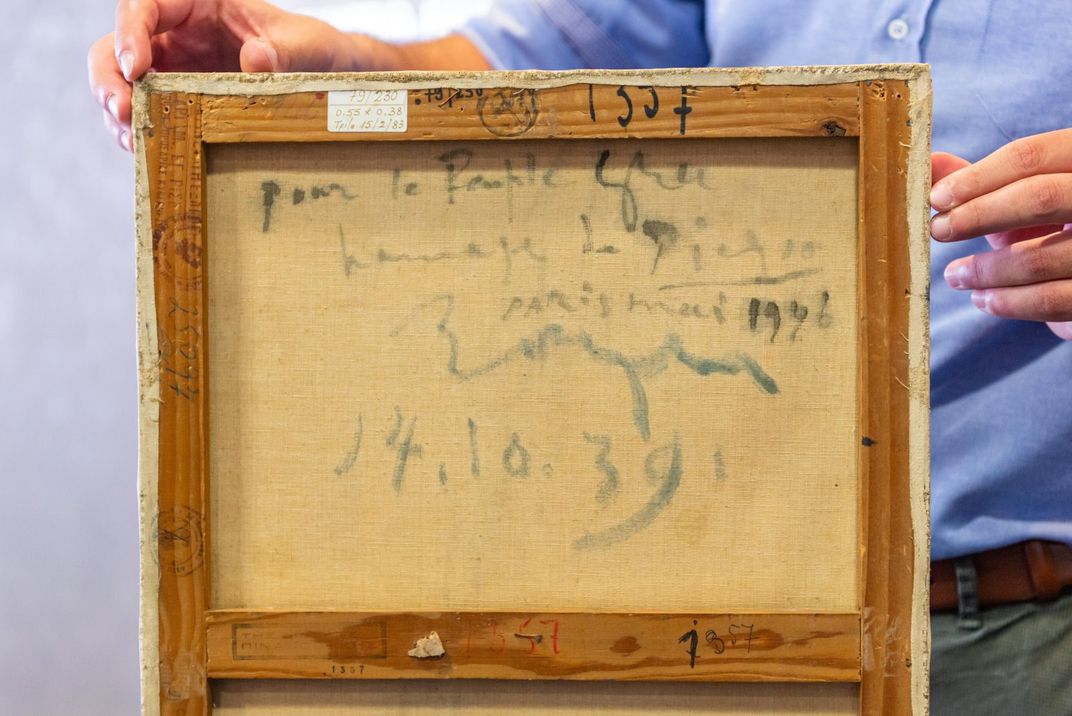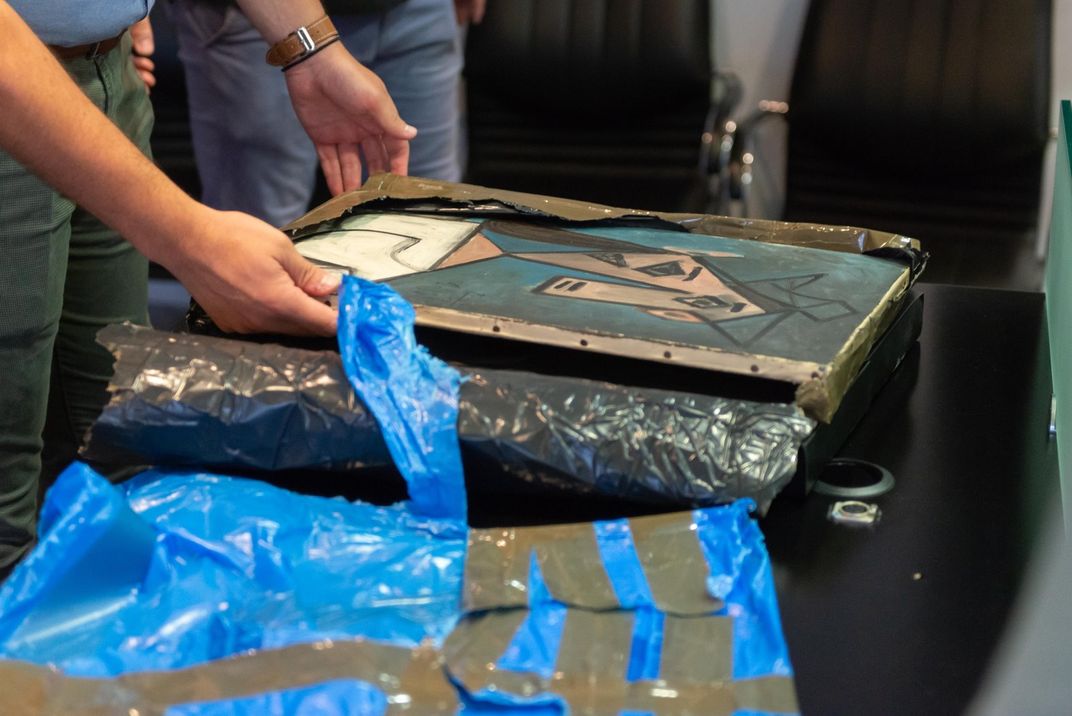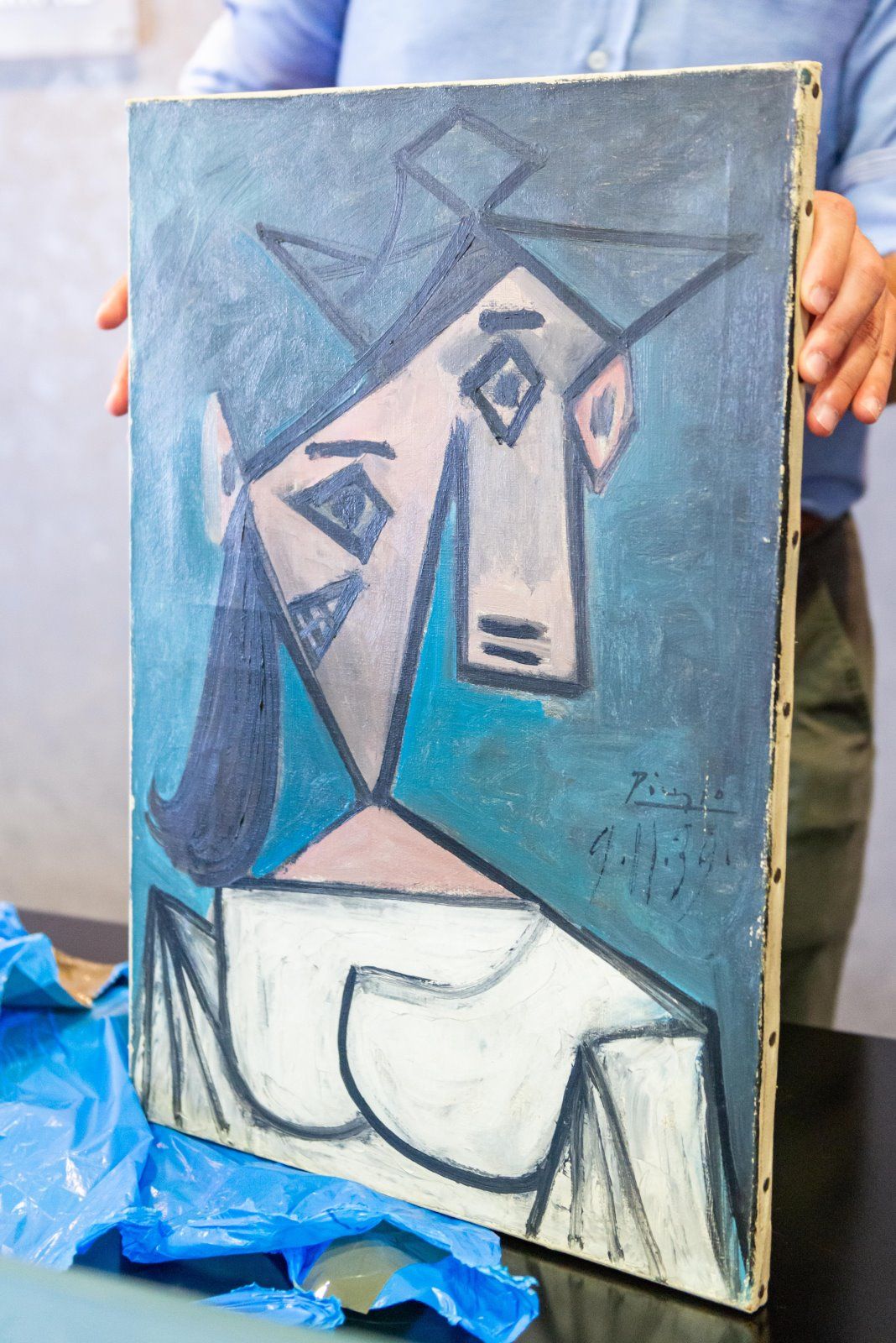How a Self-Professed ‘Art Freak’ Pulled Off a Bold Heist at Greece’s National Museum
Greek police recovered two paintings by Picasso and Mondrian, stolen 9 years ago in an early morning caper, after a 49-year-old man confessed to the crime
:focal(800x327:801x328)/https://tf-cmsv2-smithsonianmag-media.s3.amazonaws.com/filer/26/0b/260b759c-e625-4bdf-9d0f-b342a4d28346/29062021parousiash006.jpeg)
Greek police finally cracked a nine-year-old art heist this week, leading to the celebrated return of two paintings by Pablo Picasso and Piet Mondrian. These works and one unrecovered drawing were stolen from the National Gallery-Alexandros Soutsos Museum in Athens on January 9, 2012, in a sensational early-morning heist.
Acting on tips from Greek newspaper Proto Thema, police apprehended their primary suspect, construction worker George Sarmatzopoulos, on Monday, per a police statement.
To the surprise of officials, Sarmatzopoulos confessed to the theft outright. He then directed police to a dried ravine southeast of Athens, where they discovered the two stolen artworks wrapped in protective plastic and stowed underneath a thicket of brambles.
Based on the well-organized nature of the crime, police had previously assumed that the burglary was carried out by two or more people, as the Associated Press reported in 2012. But in his testimony, partially reprinted in the Greek newspaper Kathimerini, the 49-year-old divorcee claims that he alone pulled off the job.
“I want to tell you something else that I did many years ago, and it weighs on my conscience and I cannot sleep,” Sarmatzopoulos began his statement to police, as translated by the Art Newspaper and reported in Kathimerini. “In 2012, I went into the National Gallery and took three paintings. I will tell you everything in as much detail as I can remember.”
Sarmatzopoulos further claims that he began to visit the National Gallery constantly for about six months leading up to the crime, until thoughts of stealing a work for himself “tormented” him. He never planned to sell the paintings, he claims: “I hadn’t decided which work I would take, but only that I wanted to take one.”
Rather, he seems to have intended to keep the works to enjoy. The man referred to himself multiple times as an “art lover,” and used to wield the Twitter username “Art Freak,” as Helen Stoilas reports for the Art Newspaper.
Sarmatzopoulos says that he spent months collecting information on the locations of paintings, security cameras, where to enter and exit the building and when the guards typically took smoke breaks, as Helena Smith reports for the Guardian.
On a randomly chosen Sunday evening, he says that he began to intentionally set off alarms in the museum without entering the building, prompting the sole night guard on duty to disable at least one of the alarms. Around four in the morning, dressed in black, the alleged thief then entered through an unlocked balcony door and crawled into the galleries.
“I crawled into the room and started waving my arms to see if the alarm radars were working,” Sarmatzopoulos relates in his testimony, as printed in Kathimerini and translated via Google Translate. “Since I did not hear any alarm, I assumed that the guard had turned it off. I got up and found myself in front of Picasso’s painting.”
In less than seven minutes, he carefully stripped three works from their frames: Woman’s Head (1939), a Cubist portrait that Picasso made of his one-time lover Dora Maar; Piet Mondrian’s Stammer Mill (1909), an early figurative work by the Dutch artist depicting a windmill; and a work in pen and ink by Italian artist Guglielmo Caccia, dating to the 16th century.
While the two paintings were recovered this week, the third stolen work remains missing. Sarmatzopoulos tells police that the paper was damaged during the raid and that he eventually flushed it down a toilet, BBC News reports.
He stowed the works in his home and in a remote warehouse for years. Then, in January, after reading a report that police were close to solving the decade-old mystery, Sarmatzopoulos frantically moved the paintings from storage to their hiding place in the ravine, as Dimitris Popotas and Aria Kalyva report for Greek newspaper Proto Thema.
Authorities arrested the suspect on Monday after fearing that he was about to leave the country for the Netherlands, per Proto Thema.
At the time of the theft, Greece’s economy was reeling from the economic recession and a protracted debt crisis, per the Guardian. Later investigations found that limited funding led to severe security lapses at the museum, including a lack of guards, an outdated alarm system and reduced security camera coverage.
The National Gallery closed shortly after the heist in 2013 for an 8-year-long, $70-milion (€59 million) expansion, which more than doubled the museum’s size, as William Summerfield reported for the Art Newspaper in March. Though attendance remains limited due to the Covid-19 pandemic, the museum finally reopened on March 24 of this year to coincide with the 200th anniversary of Greek independence, the Ministry of Culture noted in a statement.
“Today is really a special day, a great joy but also a great emotion,” Minister of Culture and Sports Lina Mendoni said at a Tuesday press conference, per the police statement.
Mendoni notes that Picasso donated Woman’s Head to Greece in honor of the country’s resistance to Nazi Germany during World War II. On the back of the canvas, the Spanish artist wrote in French: “For the Greek people, a tribute by Picasso.” (That distinctive signature would have made the painting “impossible” to sell on the black market, the minister adds.)
“Picasso had dedicated the painting to the Greek people as a recognition of the National Resistance,” Minister of Citizen Protection Michalis Chrysochoidis said during the conference, per the statement. He noted that while “[a] Greek was found to deprive” the country of the precious painting, “Greeks were found to bring it back.”
Chrysochoidis added: “I wish all the works of art of our Greek homeland to find their natural place, to return to where they belong.”
/https://tf-cmsv2-smithsonianmag-media.s3.amazonaws.com/accounts/headshot/nora.png)





/https://tf-cmsv2-smithsonianmag-media.s3.amazonaws.com/accounts/headshot/nora.png)